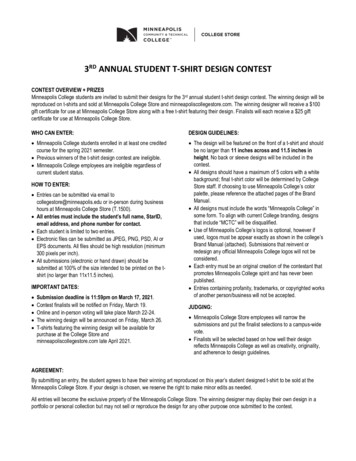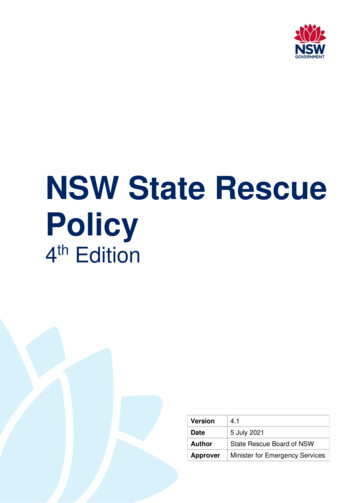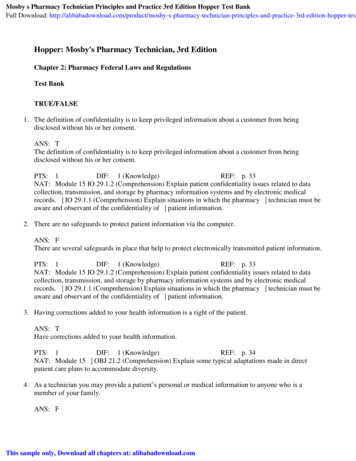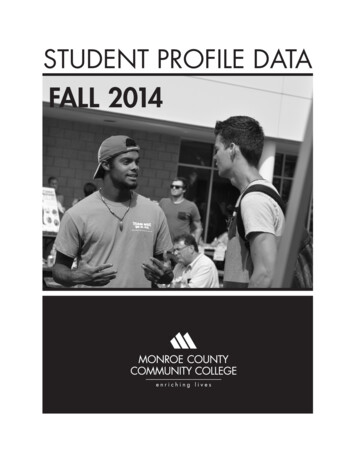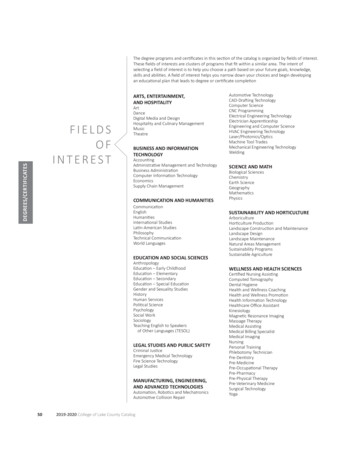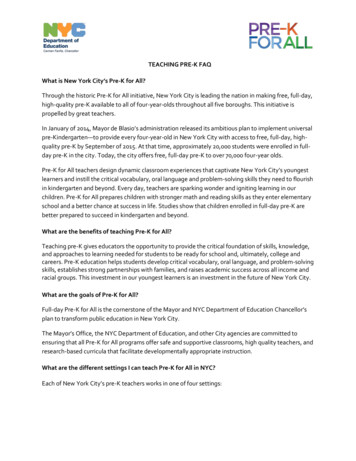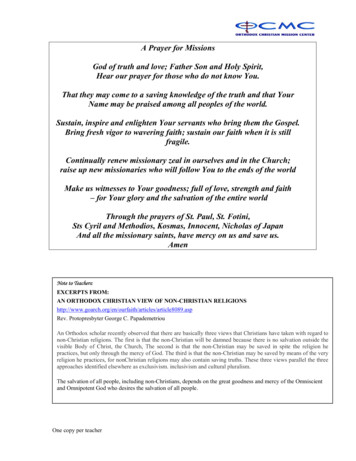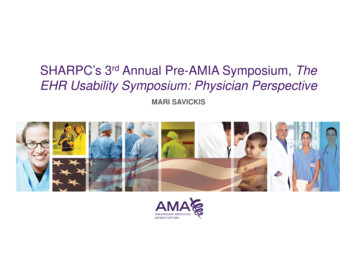
Transcription
SHARPC’s 3rd Annual Pre-AMIA Symposium, TheEHR Usability Symposium: Physician PerspectiveMARI SAVICKIS
Physician Use of Technology2
Physician Adoption of EHRs Significant uptick in past few years driven in large part byHITECHPhysicians are at a “tipping point” in terms of EHR adoption– CDC Data from 2012: 72% of doctors are using EHRs But 40% of them are just using “basic ” ones that can’t meet MU– CMS MU data from 2013: 50% of eligible professionals (mostlydoctors) have received an MU incentive. 2013 American Medical Association. All rights reserved.3
“Digital Omnivores” Doctors are not “technophobes” but poorly designed and implemented EHRs arechallenging uptakeToo often, however, doctors are painted as being anti-technologySome doctors embrace technology to a lesser degree than others, but the realityis that physicians are frequently on the cutting edge of new technology––Physicians using iPads: 72% according to Manhattan ResearchAccording to epocrates.com : “By next year, 9 in 10 healthcare providers will use smartphones, and nearly as many will haveadopted tablets.”And almost half those surveyed are considered “digital omnivores” (clinicians who routinelyuse a tablet, smartphone and laptop/desktop computer in a professional capacity).Doctors also use cutting edge technology in their procedures, readily adoptingnew treatment methods and tools to improve patient care. 2013 American Medical Association. All rights reserved.4
How Satisfied are Doctors with their EHR?5
Use Up, but Satisfaction Down While EHR use has increased, adoption challenges persistThe question, therefore, is why are physicians having more difficultyin adopting EHRs than other complex technology, and how can weremove these barriers?Primary care and internists are “early adopters” and they arestruggling with MU criteria:– ACP estimates that half of their physicians who met Stage 1 won’tparticipate in Stage 2.– AAFP estimates that approximately 20% of their physicians whoreceived an incentive in 2011 did not try to earn an incentive in 2012. 2013 American Medical Association. All rights reserved.6
American EHR Survey 139-question online survey on nationally certified EHR use andsatisfactionLooked at barriers to meeting MUSurveys conducted in conjunction with 10 different professionalsocieties between March 2010 and December 20124279 respondents – mix of small, medium and large practicesKey takeaway – physician satisfaction with their EHR is goingdown 2013 American Medical Association. All rights reserved.7
EHR Products by Satisfaction & Attestation 3 [Top 10] EHR Products by user satisfaction (e-MDs, MEDENT,Practice Fusion) are also Top 10 products by attestation (2012)Average satisfaction rating - 3.39/5 (n 4,029)These EHRs comprise 6.5% of attestationsSource: American EHR 2013 American Medical Association. All rights reserved.
EHR Products by Satisfaction & AttestationAs of August 1st 2013Source: American EHR 2013 American Medical Association. All rights reserved.9
Surveyed Physician Quote This system is extremely dysfunctional, adds toworkload, and has the potential to create dangerouspatient situations. It is completely non‐intuitive anddoes not generate any useful population‐based datafor our facility.Jan 2011 – Infectious Diseases – 8 FTE ‐ Academic Medical CentreSource: American EHR 2013 American Medical Association. All rights reserved.
Average Satisfaction with Ease of Use Over Time for 3Most Rated EHR Products53.85Average rce: American EHR 2013 American Medical Association. All rights reserved.20112012Product AProduct BProduct C
Overall EHR User Satisfaction39%4027%30202010 (n 408)21%11%100Source: American EHR 2013 American Medical Association. All rights reserved.10% increasein verydissatisfiedusers from2010-2012
RAND Report The AMA commissioned RAND to examine factors related tophysician satisfaction and the implication for payment anddelivery reformRAND explored in depth 30 practices of all sizes in 6 statesRAND didn’t have any preconceived notions about the findingsStudy released in October found physicians view EHRs and MUare among the most significant challenges that physicians faceStudy located at:http://www.rand.org/pubs/research reports/RR439.html 2013 American Medical Association. All rights reserved.13
Flavor of the Frustration “Every Screen’s got 50 different things, you know, that arechanging. It slows me down. So, I do a lot of my charting atnight But, the problem is I’m spending more hours doing it thanI would have before. We have XXX, which you have to becareful of, because I just [dictated] a ‘Patient’s prostate isbothering him’ and it turned out ‘Patient’s prostitute is botheringhim.’ You really have to read careful, because I can end up goingto court with that stuff.”– Primary care physician 2013 American Medical Association. All rights reserved.14
Meaningful Use15
Meaningful Use Physicians, despite their appetite for technology, are struggling evenin MU Stage 1 and part of this is directly attributable to thechallenges they are having with certified EHRs.– Tight statutory deadlines for both vendors and physicians ONC vendor specs not available right out of the gate– Data portability costs– Pipeline issues Not all doctors have a certified Version 2014 product– Only 2/3rd who had Version 2011 product now have Version 2014 Even if all products are V2014 certified by January 1, physicians must get inline for installs October 1 last day to certify for MU to avoid 2015 penalties – same date asICD-10 compliance 2013 American Medical Association. All rights reserved.16
The NumbersYearEPseligible forincentiveEPs at risk forpenaltiesIncentiveTop 3 3,55189.8% did not participate 18k1. Family Practice 19%2. Internal Medicine 18%3. Cardiovascular 6% 18,0002012588,15669% did not participate 12k - 18k1. Family Practice 18%2. Internal Medicine 16%3. Cardiovascular 6% 17,2032013527,00040.81% not paid 8k - 15k1. Family Practice 20%2. Internal Medicine 18%3. Cardiovascular 7% 14,39358.32% did not participate23.12% not registered 2013 American Medical Association. All rights reserved.17
Recommendations Moving Forward18
What can be done to improve EHR usability today? Things that can be done both within and outside regulatoryframeworkDon’t want to wait until “Stage 3” to solve problems– While re-opening rulemaking could be helpful, it’s also unlikely Can work proactively with vendors to identify issues, and AMA ishaving these conversations and engaging the vendor community 2013 American Medical Association. All rights reserved.19
What ONC and Vendors Can DoRecommend ONC urge vendors to:1.2.3.4.5.Not include gag clauses (that prohibit providers from sharing software problems or concerns with anyonebut the vendor) in their contracts with physicians and post online which vendors require gag clauses.Provide contractual, pre-defined specifications on data migration fees and good faith plans on maintainingcertification requirements. An online list of vendors who charge data migration fees should be posted.Include independent (vs. vendor employed) physicians and other end users during the development andtesting process, take into account different training levels and appropriate specialist designation, anddisclose their process for incorporating end users in design and acceptance testing. ONC should makeavailable online information that indicates whether the vendor uses independent vs. employed physicians.Post all vendor test reports online.Work with CMS to obtain data on physician satisfaction of their EHRs, which could be done throughexisting OMB-approved data collection vehicles such as the attestation process and the Medicare ProviderSatisfaction Survey.ONC should also:1.Require vendors to report to ONC when a product has failed certification with one ONC ATCB and to makethis information publicly available online.2.Disseminate survey results on usability experiences based on practice size, specialty type, and geographiclocation and incorporate this feedback into future certification processes.See AMA July 23rd 2013 testimony to HITPC on implementation and usability concerns with use of it-policy-committee-testimony-23july2013.pdf 2013 American Medical Association. All rights reserved.20
What else is the AMA doing to improve EHR usability? Advocating for a more flexible and less punitive approach tomeeting MU Stage 2– Tough to navigate systems may hamper a physician’s ability to meetMU – another reason why more flexibility is needed to meet MU Promoting the need for greater interoperability– AMA is a co-founding member of Healtheway (formerly the NwHIN)– We sit in the Implementation Workgroup of the HITSC– We sit on / participate in several HITPC workgroups AMA website in MU www.ama-assn.org/go/meaningfuluse 2013 American Medical Association. All rights reserved.21
My Contact InfoMari Rose SavickisAssistant Director, Federal Affairs25 Massachusetts Avenue, NWSuite 600Washington, DC 20001-7400M: (202) 294-3828O: (202) 789-7414F: (202) 789-4581Mari.savickis@ama-assn.org 2013 American Medical Association. All rights reserved.22
2013 American Medical Association. All rights reserved.
3 [Top 10] EHR Products by user satisfaction (e-MDs, MEDENT, Practice Fusion) are also Top 10 products by attestation (2012) . Require vendors to report to ONC when a product has failed certification with one ONC ATCB and to make this information publicly available online. 2. Disseminate survey results on usability experiences based on .


